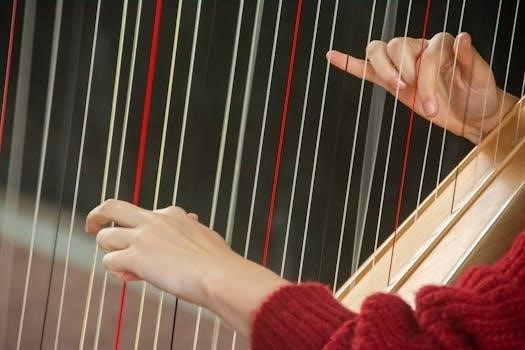Brother Serger 1034D Manual⁚ A Comprehensive Guide
Welcome to your essential guide! This manual unlocks the full potential of your Brother 1034D serger. Learn everything, from basic threading to advanced techniques. Master your machine and create beautiful, professional-looking projects with confidence using this guide.
The Brother 1034D serger is a popular choice for both beginner and experienced sewers, known for its reliability and ease of use. This serger offers a range of features that allow you to create professional-looking seams, rolled hems, and decorative edges on a variety of fabrics. Its robust construction ensures durability, making it a valuable addition to any sewing room.
This guide is designed to help you get the most out of your Brother 1034D serger. We’ll cover everything from basic threading and tension adjustments to more advanced techniques and troubleshooting tips. Whether you’re new to serging or looking to expand your skills, this manual will provide you with the information you need to achieve professional results.

The Brother 1034D’s key features include a 3 or 4 thread overlock stitch, differential feed for preventing wavy or stretched seams, and a free arm for sewing cuffs and sleeves. Understanding these features is crucial for mastering your serger and achieving the desired outcome for your projects. Let’s embark on this journey to unlock the full potential of your Brother 1034D serger!
Understanding the Manual’s Structure
This manual is structured to guide you through every aspect of using and maintaining your Brother 1034D serger. It’s organized into clear, concise sections, each addressing a specific topic. We begin with essential safety precautions to ensure a safe sewing environment. Then, we move onto the fundamental steps of threading, a crucial skill for optimal serger performance.

Next, we delve into adjusting tension settings, a key element in achieving balanced and professional-looking stitches on various fabric types. Troubleshooting common serging problems is addressed in a dedicated section, providing practical solutions to frequent issues. We also cover changing needles and loopers, along with proper cleaning and maintenance procedures to prolong the life of your machine.
Understanding differential feed is essential for controlling fabric movement and preventing puckering or stretching. The manual explores the various stitch options and techniques available on the Brother 1034D, allowing you to expand your creative possibilities. Finally, we discuss accessory feet, replacement parts, and resources for additional support. By understanding this structure, you can quickly find the information you need to master your serger.
Essential Safety Precautions
Before operating your Brother 1034D serger, it’s crucial to understand and adhere to these essential safety precautions. Always disconnect the power cord from the outlet when not in use, during cleaning, or when changing needles or loopers. Keep fingers, hair, and loose clothing away from moving parts, especially the needles and blades, to prevent injury.
Never operate the serger if it is damaged or malfunctioning. Ensure that all safety guards are in place during operation. Use only genuine Brother accessories and replacement parts to maintain the serger’s safety and performance. Avoid using the serger in damp or wet conditions to prevent electrical shock.
Supervise children closely when the serger is in use and never allow them to operate it unsupervised. Wear appropriate eye protection to shield against flying debris. Do not force the fabric through the serger; let the machine feed it naturally. If the serger makes unusual noises or vibrations, stop immediately and consult the troubleshooting section of this manual. By following these safety guidelines, you can ensure a safe and enjoyable serging experience.
Threading the Brother Serger 1034D⁚ Step-by-Step
Threading the Brother 1034D serger may seem daunting at first, but following these steps will make it manageable. Begin by raising the presser foot to release tension. Follow the color-coded threading guides printed on the machine. Start with the lower looper, then the upper looper, and finally the needles.
Ensure each thread passes through all the designated guides and tension discs; Use tweezers to assist in threading tight spots. After threading each looper and needle, pull a few inches of thread through to the back of the machine. Double-check that all threads are correctly seated in their respective guides.
Lower the presser foot and test the threading by serging a small piece of fabric. If the stitches are uneven or looping incorrectly, re-thread the machine, paying close attention to the tension settings. Refer to the diagram in the manual for a visual aid. Consistent practice will make threading the Brother 1034D a quick and easy process.
Adjusting Tension Settings for Different Fabrics
Achieving perfect serged edges requires understanding and adjusting the tension settings on your Brother 1034D. Tension refers to the amount of pull on each thread as it forms a stitch. Different fabrics require different tension settings to create a balanced and professional-looking seam. Lightweight fabrics like silk or chiffon typically need lower tension settings to prevent puckering.

Heavier fabrics such as denim or fleece require higher tension to ensure a strong and secure seam. To adjust the tension, use the dials located on the front of the machine, each corresponding to a specific thread path. Always test your tension settings on a scrap piece of the fabric you’ll be using for your project.
If the stitches are too loose, increase the tension. If the stitches are too tight, decrease the tension. A balanced stitch will have threads that interlock evenly on the edge of the fabric. Consult your manual for suggested tension settings for various fabric types as a starting point for your adjustments.
Troubleshooting Common Serging Problems
Even with a well-maintained serger, you may encounter occasional problems. One common issue is skipped stitches, often caused by incorrect needle size or type for the fabric. Ensure you’re using the appropriate needle and that it’s correctly inserted. Another frequent problem is uneven or loopy stitches, typically related to tension imbalances.
Double-check your tension settings and adjust them accordingly, referring to your fabric type. Thread breakage can occur if the thread is old, damaged, or not properly threaded through the machine. Replace the thread and carefully re-thread the serger, following the correct path as shown in the manual.
Fabric puckering can result from excessive tension or an incorrect differential feed setting. Reduce the tension and adjust the differential feed to a lower setting for smoother seams. If you experience difficulty feeding the fabric, check for lint or debris obstructing the feed dogs. Clean the area thoroughly to ensure proper fabric advancement.
Changing Needles and Loopers
Properly functioning needles and loopers are essential for optimal serger performance. Changing needles is a straightforward process. First, turn off and unplug your serger for safety. Locate the needle clamp screws and use the provided screwdriver to loosen them. Remove the old needles and insert new ones, ensuring the flat side of the needle shank faces the rear.
Tighten the needle clamp screws securely. Replacing loopers is less frequent but necessary when they become damaged or worn. Consult your manual for the specific looper replacement procedure for your Brother 1034D model. This typically involves removing screws or clips that hold the looper in place.
Carefully remove the old looper and insert the new one, ensuring it is properly aligned and secured. Refer to diagrams in the manual to guarantee correct placement. After replacing either needles or loopers, always test the serger on scrap fabric to verify proper stitch formation and tension before working on your project.
Cleaning and Maintaining Your Serger

Regular cleaning and maintenance are crucial to keep your Brother 1034D serger running smoothly and prevent issues. Before cleaning, always unplug the machine to avoid accidental activation. Use the provided brush or a small vacuum cleaner to remove lint and thread buildup from around the needles, loopers, and feed dogs. Pay close attention to areas where lint tends to accumulate.
Oil the serger regularly, following the oiling points indicated in your manual. Use only sewing machine oil; other oils can damage the machine. Place a drop or two of oil on each designated point, then run the serger briefly to distribute the oil. Wipe away any excess oil with a soft cloth.
Periodically clean the serger’s exterior with a damp cloth. Avoid using harsh chemicals or abrasive cleaners. Store your serger in a clean, dry place, preferably covered, to protect it from dust and damage. Routine care ensures longevity and consistent performance.
Understanding Differential Feed
Differential feed is a vital feature of your Brother 1034D serger, controlling fabric movement during sewing. It uses two sets of feed dogs that can move independently, allowing you to adjust how the fabric feeds through the machine. Understanding this feature is key to achieving professional-looking results on various fabric types.
The differential feed ratio determines the relative speed of the front and rear feed dogs. A setting of 1.0 indicates equal speed, resulting in no gathering or stretching. Increasing the ratio (e.g., 1.5 or 2.0) causes the rear feed dogs to move faster, creating a gathering effect, ideal for ruffles or easing fabric. Decreasing the ratio (e;g., 0.5 or 0.7) makes the front feed dogs move faster, stretching the fabric slightly, perfect for preventing wavy seams on knit fabrics.
Experiment with different differential feed settings on scrap fabric to understand their impact. Adjust it based on the fabric’s weight and stretch to achieve flat, even seams or desired gathering effects. Mastering differential feed will significantly enhance your serging capabilities.
Exploring Stitch Options and Techniques
The Brother 1034D serger offers a range of stitch options beyond a standard overlock. Understanding these options expands your creative possibilities. This section explores various stitches and techniques to elevate your serging projects. Experimentation is key to unlocking the full potential of your machine;
The 4-thread overlock stitch is a durable, versatile option for seams and edges. The 3-thread overlock is lighter, ideal for delicate fabrics or rolled hems. The rolled hem creates a neat, narrow edge, perfect for lightweight fabrics like chiffon. The narrow hem is a variation of the rolled hem for an even finer finish. Flatlock stitching, achieved by adjusting tension, creates a decorative, flat seam, great for activewear.
Beyond basic stitches, explore techniques like chain stitching, cover stitching (requires additional accessories), and using decorative threads for unique effects. Practice each stitch on different fabrics to understand its characteristics and applications. Don’t be afraid to experiment with tension and differential feed settings to achieve your desired look. Mastering these stitch options will transform your serging projects.
Accessory Feet and Their Uses
Unlock the full potential of your Brother 1034D serger with its range of accessory feet. These specialized feet enhance precision and efficiency, allowing you to tackle diverse projects with ease. Understanding each foot’s purpose is crucial for achieving professional results. This section details the common accessory feet and their specific applications.
The blind hem foot creates invisible hems on skirts and trousers, providing a clean, professional finish. The gathering foot evenly gathers fabric, ideal for creating ruffles and embellishments. The piping foot attaches piping to edges with precision, adding a decorative touch to garments and home décor items. The elastic foot allows you to sew elastic directly onto fabric edges, perfect for lingerie and swimwear.
Other useful feet include the lace foot for attaching delicate lace, and the beading foot for adding beads and sequins; Always consult your manual for proper attachment and usage instructions. Experiment with different feet to discover new techniques and expand your serging capabilities. Investing in a few key accessory feet can significantly improve the quality and versatility of your projects.
Finding Replacement Parts
Maintaining your Brother 1034D serger involves occasional replacement of worn or damaged parts. Identifying the correct replacement part is crucial for ensuring optimal performance and longevity of your machine. Several avenues exist for sourcing these parts, both online and offline; This section guides you through the process of locating and acquiring the necessary components.
Start by consulting your Brother 1034D manual. It contains a detailed parts list with corresponding part numbers. This information is essential when searching for specific components. Authorized Brother dealers are a reliable source for genuine replacement parts. They offer expert advice and ensure compatibility with your serger model. Online retailers specializing in sewing machine parts also provide a wide selection. However, verify the part’s authenticity and compatibility before purchasing.
When ordering online, carefully compare part numbers and descriptions. Consider the seller’s reputation and return policy. For commonly replaced items like needles and blades, stocking up can save time and money in the long run. Regularly inspecting your serger for wear and tear allows you to proactively identify and replace parts, preventing further damage and ensuring smooth operation.
Resources and Support
Navigating the world of serging can sometimes present challenges. Fortunately, a wealth of resources and support networks are available to assist you with your Brother 1034D serger. Whether you’re a beginner or an experienced user, these resources can provide valuable information and guidance.
The official Brother website is an excellent starting point. It often features FAQs, troubleshooting guides, and downloadable manuals. Online forums and communities dedicated to sewing and serging offer a platform to connect with other users. You can ask questions, share tips, and learn from others’ experiences. YouTube is another valuable resource, with numerous tutorials and demonstrations showcasing various serging techniques and projects using the Brother 1034D.
Consider joining local sewing or quilting groups. These groups provide hands-on learning opportunities and a supportive environment for sharing knowledge. Your local Brother dealer can also offer technical support and advice. Don’t hesitate to reach out to Brother’s customer service for assistance with specific issues or concerns. Remember, continuous learning and seeking support are key to mastering your serger and achieving successful results.

No Responses